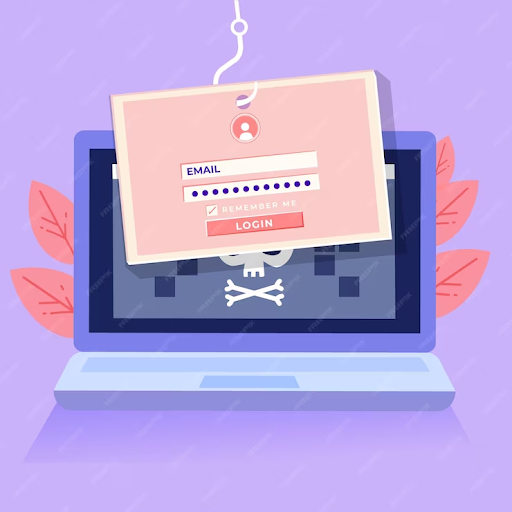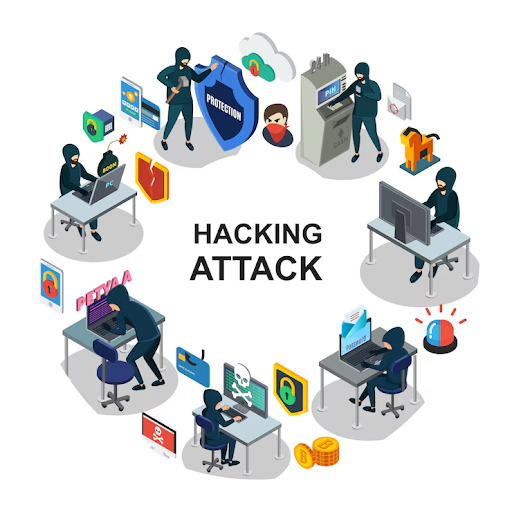Phishing attacks are a constant threat in today’s digital world. These deceptive attempts aim to steal your personal information, login credentials, or financial details. But fear not! By understanding the tactics used by phishers and knowing how to identify them, you can effectively protect yourself.
This comprehensive guide equips you with the knowledge and tools to spot phishing attacks in their tracks, keeping your online identity and finances safe.
What is Phishing?
Phishing is a type of cyber attack that disguises itself as a legitimate source, such as a bank, social media platform, or even a friend. Phishing emails, texts, or fake websites lure unsuspecting users into revealing sensitive information.
Common Signs of a Phishing Attack:
- Urgency and Pressure: Phishing messages often create a sense of urgency, urging you to act immediately. This tactic plays on your emotions and reduces your ability to think critically. Watch out for phrases like “urgent action required” or “account suspended – click here to reactivate.”
- Suspicious Sender: Be wary of emails or messages from unknown or unrecognized senders. Legitimate companies will typically use their official domain name in their email address. Don’t be fooled by slight variations in spellings – a genuine bank email won’t have typos like “[email address removed]”.
- Grammatical Errors and Typos: Legitimate companies invest in professional communication. Phishing attempts, however, are often riddled with grammatical errors, spelling mistakes, and awkward phrasing. These inconsistencies can be a red flag.
- Suspicious Links and Attachments: Don’t click on links or open attachments from unknown senders. Hover over the link to see the actual URL before clicking. Phishing links might look legitimate at first glance, but they could lead to a malicious website designed to steal your information.
- Unrealistic Offers and Threats: Phishing messages often lure you in with promises of too-good-to-true deals or threaten negative consequences if you don’t comply. For example, a phishing email claiming you’ve won a lottery you never entered, or a fake bank notification threatening account closure if you don’t “verify your information.”
How to Protect Yourself from Phishing Attacks:
- Be cautious with links and attachments: Never click on suspicious links or open attachments from unknown senders.
- Verify the sender: If you receive an email or message from a seemingly legitimate source, double-check the sender’s email address for any discrepancies.
- Don’t share personal information readily: Legitimate companies will rarely, if ever, request sensitive information via email or text. Be wary of any message asking you to confirm your password, bank account details, or Social Security number.
- Strengthen your passwords: Use strong, unique passwords for all your online accounts. Consider using a password manager to generate and store complex passwords securely.
- Enable two-factor authentication (2FA): Whenever possible, activate 2FA for your online accounts. This adds an extra layer of security by requiring a secondary verification code in addition to your password when logging in.
- Stay informed: Keep yourself updated on the latest phishing tactics. Many security software companies and government agencies publish resources to educate users about online threats.
Phishing Attacks: A Threat in the Digital Age
Phishing attacks are a major concern in today’s online world. These deceptive attempts aim to steal your personal information, login credentials, or financial details. They often come disguised as emails, text messages, or fake websites from seemingly legitimate sources like banks, social media platforms, or even friends.
Understanding the Tactics:
Phishers exploit human psychology to trick you into giving away your information. Here are some common tactics they use:
- Urgency and Pressure: Phishing messages often create a sense of urgency, urging you to take immediate action. They might use phrases like “urgent action required” or “account suspended – click here to reactivate.” This tactic plays on your emotions and reduces your critical thinking.
- Spoofed Identities: Phishing attempts can appear to be from a trusted source, such as your bank or a popular online service. They might use email addresses or website URLs that closely resemble the legitimate ones, hoping you won’t notice the subtle discrepancies.
- Fear and Intimidation: Some phishing messages threaten negative consequences if you don’t comply, such as account closure or legal action. This can create fear and pressure you into acting impulsively.
- Tempting Offers: Phishing attempts might lure you in with promises of too-good-to-true deals or prizes. For example, a fake email claiming you’ve won a lottery you never entered.
Spotting the Signs:
Being vigilant is key to avoiding phishing attacks. Here are some red flags to watch out for:
- Suspicious Sender: Be wary of messages from unknown or unrecognized senders. Legitimate companies will typically use their official domain name in their email address.
- Grammatical Errors and Typos: Legitimate companies invest in professional communication. Phishing attempts, however, are often riddled with grammatical errors, spelling mistakes, and awkward phrasing.
- Suspicious Links and Attachments: Don’t click on links or open attachments from unknown senders. Hover over the link to see the actual URL before clicking. Phishing links might look legitimate at first glance, but they could lead to a malicious website designed to steal your information.
- Unrealistic Offers and Threats: Be skeptical of messages offering unrealistic rewards or threatening negative consequences if you don’t comply.
Protecting Yourself:
By following these steps, you can significantly reduce your risk of falling victim to a phishing attack:
- Be Cautious with Links and Attachments: Don’t click on suspicious links or open attachments from unknown senders.
- Verify the Sender: If you receive a message from a seemingly legitimate source, double-check the sender’s email address for any discrepancies.
- Don’t Share Personal Information Readily: Legitimate companies will rarely, if ever, request sensitive information via email or text. Be wary of any message asking you to confirm your password, bank account details, or Social Security number.
- Strengthen Your Passwords: Use strong, unique passwords for all your online accounts. Consider using a password manager to generate and store complex passwords securely.
- Enable Two-Factor Authentication (2FA): Whenever possible, activate 2FA for your online accounts. This adds an extra layer of security by requiring a secondary verification code in addition to your password when logging in.
- Stay Informed: Keep yourself updated on the latest phishing tactics. Many security software companies and government agencies publish resources to educate users about online threats.
Advanced Techniques for Phish Detection
While the basic signs of phishing attacks are crucial to know, cybercriminals are constantly evolving their tactics. Here are some advanced techniques to stay ahead of the curve:
- Look for Social Engineering: Phishers often use social engineering techniques to manipulate your emotions and gain your trust. Be wary of messages that try to create a sense of urgency, fear, or excitement. These tactics are designed to cloud your judgment and make you more likely to click on a malicious link or reveal personal information.
- Beware of Personalized Attacks: Phishing attempts are becoming increasingly sophisticated. Cybercriminals might use information gleaned from data breaches or social media profiles to personalize their attacks. For example, a phishing email might address you by name and reference recent purchases you’ve made, making it appear more legitimate.
- Suspicious Requests for Remote Access: Never grant remote access to your computer or devices to anyone you don’t know and trust explicitly. Phishing attempts might disguise themselves as technical support requests, urging you to download software or grant remote access to “fix” a problem.
- Phishing Websites with Security Certificates: Some phishing websites might display fake security certificates or HTTPS encryption symbols to appear legitimate. While these certificates can be spoofed, it’s still a good security practice to check the website’s URL for any inconsistencies before entering any personal information.
- Stay Informed About Current Phishing Scams: Phishing tactics are constantly evolving. Staying updated on the latest scams and trends will help you recognize them. Many security software companies and government agencies publish alerts and resources to educate users about current phishing threats.
What to Do If You Encounter a Phishing Attempt
If you suspect you’ve encountered a phishing attempt, here’s what to do:
- Do Not Click on Links or Open Attachments: The most important step is to avoid engaging with the phishing message in any way. Don’t click on links, download attachments, or respond to the sender.
- Report the Phishing Attempt: Many email providers and social media platforms offer ways to report phishing attempts. This helps them track and block similar attacks in the future. You can also report phishing attempts to relevant government agencies.
- Change Your Passwords: If you believe you might have entered your login credentials on a phishing website, immediately change your passwords for the affected accounts. Consider enabling two-factor authentication (2FA) for added security.
- Scan Your Device for Malware: If you click on a suspicious link in a phishing email, it’s wise to run a scan with your antivirus or anti-malware software to check for any potential threats.
By understanding the tactics used by phishers and implementing these security measures, you can significantly reduce your risk of falling victim to a phishing attack. Remember, staying vigilant and practicing safe online habits are your best defenses against these deceptive attempts.
Why Security Awareness Training Matters
Technology plays a crucial role in safeguarding yourself from phishing attacks. However, the human element remains equally important. Security awareness training can significantly enhance your ability to identify and avoid phishing attempts.
Here’s how:
- Empowering Users: Security awareness training equips users with the knowledge and skills to recognize phishing tactics. Training programs typically cover common phishing techniques, red flags to watch out for, and best practices for protecting personal information online.
- Building a Culture of Security: Effective security awareness training goes beyond simply teaching users to identify phishing attempts. It fosters a culture of security within an organization, encouraging employees to be vigilant and report suspicious activity.
- Phishing Simulations: Many security awareness training programs incorporate phishing simulations. These simulations expose users to realistic phishing attempts in a controlled environment. This allows them to practice their detection skills and learn from their mistakes without any real-world consequences.
Conclusion: Stay Safe, Stay Vigilant
Phishing attacks are a constant threat in today’s digital world. However, by understanding their tactics, implementing security measures, and staying vigilant, you can significantly reduce your risk of falling victim.
Here’s a quick recap:
- Be skeptical of unsolicited messages: Don’t click on links or open attachments from unknown senders.
- Verify the sender and website URL: Double-check email addresses and website URLs for any discrepancies.
- Beware of urgency, fear, and tempting offers: Don’t let emotions cloud your judgment.
- Enable two-factor authentication (2FA): This adds an extra layer of security to your online accounts.
- Stay informed about current phishing scams: Knowledge is power!
- Report phishing attempts: Help others stay safe by reporting suspicious activity.
By following these tips and adopting a proactive approach to security, you can navigate the digital world with confidence, knowing you’re well-equipped to identify and avoid phishing attempts. Remember, cybersecurity is a shared responsibility. By staying vigilant and taking steps to protect your information, you not only safeguard yourself but also contribute to a safer online environment for everyone.





